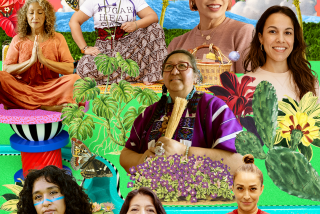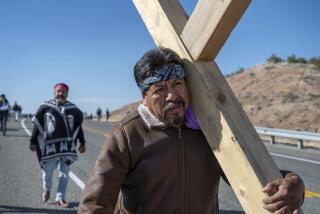Doctor Bridges the Gap Between Healing, Prayer : Medicine: Physician cites scientific evidence that faith has positive effect on patients. He uses it in his practice.
- Share via
But thou, when thou prayest, enter into thy closet, and when thou hast shut thy door, pray to thy Father which is in secret, and thy Father which seeth in secret shall reward thee openly. --Matthew 6:6, King James Translation
*
The lecture room of the C.G. Jung Institute in West Los Angeles had assumed a sacred air as Saturday’s workshop group filtered back in after a lunch break.
The background music was Bach’s “Sheep May Safely Graze” and a panel of stained glass windows was projected on the front screen.
Those were not the props for a worship service, however, but to emphasize the day’s theme of prayer and healing--an old subject presented in a new light.
Workshop leader Dr. Larry Dossey wasn’t talking about mysteries, miracles or faith healers. He was citing scientific evidence, drawn from laboratory tests performed under rigorous scientific controls, that faith heals.
“One of the best-kept secrets in medical science is the enormous body of evidence showing that prayer works,” he told his audience last week. “I want to take this out of the laboratory and show it to ordinary people.”
That’s the theme of his new book, “Healing Words: The Power of Prayer and the Practice of Medicine” (Harper/San Francisco). Not only does he document a large body of empirical research, he examines all aspects of prayer and its results.
“If you think your consciousness might make a difference in the physical state of the world, know that first-rate physicists have also taken this point of view,” Dossey told his audience.
Clicking slides onto the screen, he reviewed experiments conducted in medical schools, hospitals, laboratories and research foundations in which prayer was demonstrated to have positive effects for people with high blood pressure, wounds, heart attacks and headaches; and in which prayer for lower organisms, such as bacteria, seedlings and fungi, influenced mutation rates, growing rates and germination.
The conclusion: Prayer is a valid healing tool.
Dossey, 53, a physician who served as battalion surgeon in Vietnam and chief of staff of Medical City, Dallas Hospital, has spent years tracking down such studies in obscure medical journals, Ph.D. dissertations and parapsychology journals. He sees prayer as a partner, not a substitute for drugs and surgery. But because words like “the soul” and “prayer” don’t fit a scientific agenda, he said, “the medical profession has skirted a gold mine of information, picking and choosing only what we wanted.”
It was the realization that this gold mine existed that set Dossey on his quest after 20 years as a physician “doing my best to ignore this area.”
*
In a pre-workshop interview, the soft-spoken Texan described his own spiritual journey from Texas Bible-Belt childood adult agnostic. It led him to studies of Eastern philosophies, particularly Buddhism and Taoism. He discovered a kindred Western spiritual tradition, both in Hebrew sripture and medieval Christianity, of praying in ways that recognize silence and the unconscious. For him, personal meditation was more satisfactory than his childhood images of prayer as “pleading with an elderly, robed, bearded white male who preferred English.”
Although as a practicing internist he considered himself a scientific physician, and dismissed traditional “talking to God” prayer as superstition, he stumbled across experimental data linking prayer and healing.
“These studies showed clearly that prayer can take many forms,” writes Dossey, who lives in Santa Fe. “Results occurred not only when people prayed for explicit outcomes, but also when they prayed for nothing specific.”
He found the activity remarkable. “You put the people doing the praying 15 kilometers away from a fungus, the micro-organism,” he said, describing one research project. “One group prays for the fungal culture to increase in size; another for it to decrease in size, and you have controls that don’t get prayed for either way. The prayed ones grow faster, the others grow slower. This is called a controlled laboratory experiment.
“I’m a science junkie and I knew it couldn’t be true, but yet there was the data,” he said. “If groups are treated the same except for one intervention and they behave differently, you assume that the intervention made the difference.”
As a scientist, he decided that withholding prayer from his patients would be the equivalent of withholding treatment. So he added prayer to his medical practice, not in the patient’s presence (“I emphatically do not believe that physicians should impose their spiritual beliefs on patients”), but by meditating in his office before each day’s rounds. He didn’t invoke specific requests, but prayerful phrases such as “may the best outcome prevail,” “Thy will be done,” or “Let it be.”
In the absence of any scientific controlled studies, he had no proof of his efficacy as a praying physician. “I believe the answer is ‘yes,’ however, if for no reason than I felt more connected with those I served.”
What he had done, however, was to slightly close the gap that traditionally separates science and religion. “Science remains the most powerful metaphor in the culture,” he said. “I’m suggesting the possibility for harmonization of the analytic and the intuitive worlds.”
That has been his single focus for the past 10 years.
As a researcher and writer investigating the mysterious intersection between mind and body, Dossey has produced articles and books and attained an international reputation as lecturer. In 1988, he was the only physician invited to deliver the annual Mahatma Gandhi Memorial Lecture in New Delhi.
Although a partnership between science and spirituality has been taboo in modern times, he sees “a great shift going on before our eyes,” he said.
*
One example of the change is the new Office of Alternative Medicine established in January by the National Institutes of Health to explore such therapies outside mainstream healing as herbal medicine, acupuncture, homeopathy and spiritual healing. (One in three Americans turn to such alternative treatments, according to a recent study.)
Dossey is co-chairman of the Mind/Body Interventions Panel of the new office. The research will include healing by prayer.
All this suggests that the medical Establishment is slowly enlarging its definition of science, says Jeffrey S. Levin, associate professor at Eastern Virginia Medical School, who studies the epidemiology of religion.
“Larry Dossey is correct--this is a huge body of work that has lain dormant,” he said. “I don’t think people were aware of the scope of research out there, or how clean much of it is, until he started poking around.”
And although Western medical schools have been wedded to a mechanistic world view that breaks everything down to molecules and atoms, Levin sees increasing acceptance, particularly among younger doctors, of “some type of force or influence we aren’t yet able to measure. . . . This is different from a deity God who decides to heal somebody.
“I think this book is going to be an opening,” he added.
That is Dossey’s hope. “I want to suggest there is some psychological state we may need to engage more aggressively in this society,” he told his audience at the Jung Institute.
The evidence that prayer is more than an act of faith, he says, has profound implications for both the medical and religious communities.
“If we recognized that a doctor’s belief can actually influence the action of medications, it could change the way doctors practice medicine and the way patients choose doctors,” he said.
It would also “stretch the canvas” for organized religion, which tends to see prayer in a utilitarian way.
“I think the spiritual implications of prayer dwarf the utilitarian functions of healing. Prayer helps the human being overcome the universal fear of death; it tells us there is more.
“We are talking about immortality.”






